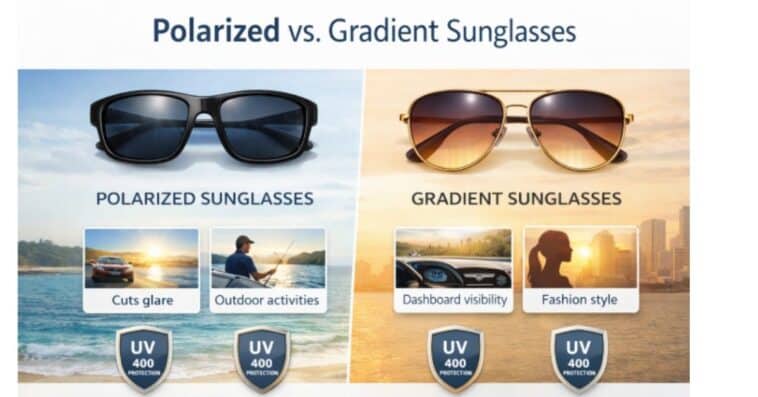Contents
hide
Polarized vs. Gradient Sunglasses: What’s the Difference?
Polarized and gradient sunglasses both protect your eyes, but they work in different ways. The best choice for you depends on the environments in which you plan to wear them and the activities you will be doing.
Polarized sunglasses are specifically designed to reduce glare. Glare refers to the bright, often blinding light that reflects off surfaces such as water, roads, or snow. For this reason, polarized lenses are especially useful when driving or spending time outdoors.
Gradient sunglasses have lenses that are darkest at the top and gradually become lighter toward the bottom. The darker upper portion helps block sunlight from above, while the lighter lower portion allows clearer downward vision, such as when reading or checking a device.
It is important to understand that neither polarized nor gradient lenses automatically provide protection against harmful ultraviolet (UV) rays. To protect your eyes, always choose sunglasses labeled UV400 or 100% UV protection.
What Are Polarized Lenses?
Polarized lenses are designed to reduce glare. Glare occurs when sunlight reflects off flat, shiny surfaces such as water, ice, sand, or roads.
Glare is caused by light that is reflected in a horizontal direction. Polarized lenses contain a special filter that blocks this type of glare while still allowing useful light to pass through. This can help you see more clearly and feel more comfortable in bright sunlight.
Benefits of polarized lenses:
- They significantly reduce glare from reflective surfaces.
- They can also help you see details more clearly by improving contrast and sharpness.
- Polarized lenses can also help reduce eye fatigue in bright sunlight.
- Wearing polarized lenses can make driving or spending time outdoors more comfortable for your eyes.
Because of these benefits, eye doctors often recommend polarized lenses for things like:
- Driving
- Fishing and boating
- Beach and water activities
- People with light sensitivity
What Are Gradient Sunglasses?
Gradient sunglasses are darkest at the top and get lighter toward the bottom. The dark top blocks sunlight from above. The lighter bottom helps you see better when you look down.
Unlike polarized lenses, gradient lenses are not made to block glare from shiny surfaces. They’re meant to balance light and keep your eyes comfortable, so they’re good for everyday use, not for really bright or super reflective places.
Gradient lenses are commonly chosen for:
- Everyday wear
- Driving, especially to keep the dashboard easy to see
- Style-focused sunglasses
- Situations where sunlight mainly comes from above rather than reflecting upward
Types of Gradient Sunglasses
Not all gradient sunglasses are identical. The manner in which the tint transitions across the lens can affect both comfort and visual clarity in various situations.
- Single-gradient lenses are darkest at the top and gradually become lighter toward the bottom. This design helps block sunlight from above and makes it easier to see when looking downward.
- Double gradient lenses are darkest at both the top and bottom, with a lighter area in the center. This configuration helps soften light entering from multiple directions.
- Reverse gradient lenses are darkest at the bottom and become lighter toward the top. This style may be selected for aesthetic reasons or to address specific lighting needs.
- Mirrored gradient lenses combine a gradient tint with a reflective surface. This design reflects additional light and provides the sunglasses with a distinctive, modern appearance.
- Photochromic gradient lenses change how dark they are depending on the light around you. They get darker outside and lighter indoors.
Some sunglasses have both a gradient tint and polarization. These lenses help control brightness and cut down glare, so they’re a good choice if you want comfort and clearer vision in bright places.
Polarized vs. Gradient Sunglasses: Side-by-Side Comparison
If you’re choosing between the two, polarized lenses are best for cutting glare and helping you see clearly in bright sunlight. Gradient lenses are mainly for comfort and managing brightness. Remember, UV protection comes from the label, not the lens type.
| Feature | Polarized Lenses | Gradient Lenses |
| Glare reduction | ✅ Excellent | ⚠️ Limited |
| Driving | ✅ Very good | ✅ Good |
| Fishing / boating | ✅ Best choice | ❌ Not ideal |
| Outdoor sports | ✅ Excellent | ⚠️ Moderate |
| Dashboard visibility | ⚠️ Reduced | ✅ Better |
| Fashion appeal | ⚠️ Limited | ✅ Very popular |
| UV protection | ❌ Only if UV400 | ❌ Only if UV400 |
How Do Polarized Lenses Work?
Polarized lenses have a thin filter that blocks glare from flat surfaces like water, roads, or snow. The filter still lets in the good light, so you can see more clearly.
By cutting down glare, polarized lenses can:
- Make details appear sharper.
- Reduce the need to squint.
- Ease eye fatigue in bright sunlight.
Polarized lenses are especially helpful if you spend a lot of time outside or driving. By cutting down harsh reflected light, they help your eyes stay relaxed and comfortable in bright conditions.
How Do Gradient Lenses Work?
Gradient lenses are darkest at the top and become lighter toward the bottom. The darker upper portion blocks sunlight from above, while the lighter lower portion makes it easier to read or view a dashboard.
Gradient lenses do not block glare as effectively as polarized lenses. They are designed to balance brightness and maintain eye comfort during everyday activities.
Do Polarized Lenses Offer Better UV Protection?
Polarization alone does not protect your eyes from harmful ultraviolet (UV) rays.
UV protection is a separate feature that must be built into the lens. Both polarized and gradient sunglasses can offer UV protection only if they are labeled:
- UV400
- 100% UVA/UVB protection
If your sunglasses do not provide adequate UV protection, especially if the lenses are dark, they may actually increase your eyes’ risk. This is because your pupils dilate behind dark lenses, allowing more harmful UV rays to enter.
Gradient Sunglasses: Pros and Cons
Pros
- They help reduce the brightness of sunlight coming in from above.
- Gradient lenses can help your eyes feel more comfortable in normal lighting.
- They can help you see more clearly when you’re reading or driving, especially when you look down through the lighter part of the lens.
- Gradient sunglasses are also popular because they look stylish and are easy to find.
Cons
- They don’t cut glare as well as polarized lenses.
- Gradient lenses aren’t as good at blocking glare from things like water or snow.
- They might not be the best choice for really bright or intense outdoor conditions.
- The amount of UV protection you get from gradient lenses depends on the lens’s quality and whether it’s labeled as UV-protected.
Which Is Better: Polarized or Gradient Sunglasses?
There’s no one best option for everyone. The right choice depends on what you’ll be doing and where you’ll be wearing your sunglasses.
Polarized sunglasses are usually best if you drive a lot, spend time near water or snow, or deal with glare that makes your eyes tired. By cutting down reflected light, they make bright places easier on your eyes.
Gradient sunglasses are often better if you want comfort and style for everyday use. They’re especially helpful when you need to see your dashboard, read, or move between indoor and outdoor areas.
For many people, the most comfortable sunglasses have both polarization, a gradient tint and UV400 protection. This way, you get glare reduction, balanced brightness, and full UV protection all in one pair.
Summary: Polarized vs. Gradient Sunglasses
Polarized and gradient sunglasses each have their own job when it comes to protecting your eyes and helping you see clearly.
Polarized lenses are best for cutting glare and keeping your vision clear, especially when you’re outside or driving. Gradient lenses are a good pick if you want to control brightness, stay comfortable in normal lighting, or just like how they look.
Remember, neither lens type blocks UV rays automatically. To keep your eyes healthy, always pick sunglasses labeled UV400 or 100% UV protection, no matter which style you like.






